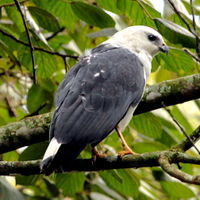White-Necked Hawk
 From Conservapedia
From Conservapedia | White-necked Hawk | |
|---|---|

| |
| Scientific classification | |
| Kingdom Information | |
| Domain | Eukaryota |
| Kingdom | Animalia |
| Subkingdom | Bilateria |
| Branch | Deuterostomia |
| Phylum Information | |
| Phylum | Chordata |
| Sub-phylum | Vertebrata |
| Infraphylum | Gnathostomata |
| Class Information | |
| Superclass | Tetrapoda |
| Class | Aves |
| Sub-class | Neornithes |
| Infra-class | Neoaves |
| Order Information | |
| Order | Accipitriformes |
| Sub-order | Accipitres |
| Family Information | |
| Superfamily | Accipitroidea |
| Family | Accipitridae |
| Sub-family | Buteoninae |
| Genus Information | |
| Genus | Buteogallus |
| Species Information | |
| Species | B. lacernulata |
| Synonyms | Leucopternis lacernulata |
| Population statistics | |
| Population | 3,500-15,000 (2016 est.)[1] |
| Conservation status | Vulnerable[2] |
The white-necked hawk (Buteogallus lacernulata) is a bird of prey of the family Accipitridae, and found in eastern Brazil[3][4].
Description[edit]
The white-necked hawk is small, about 16.8 to 18.8 inches long, and a wingspan of 35.7 to 39.7 inches. Females are slightly larger than males. It has a pure white head and lower body, while the upper parts are dark to blackish gray, and mottled in places with small white spots; in flight the coloration of the bird can cause it to be mistaken for a pigeon. The wings are a light gray underneath, with the primary and secondary flight feathers tipped in black, giving the bird an outline. The tail is short and white, with narrow black bands at the base and at the tip.
Range and habitat[edit]
The white-necked hawk is found in the Atlantic coastal forests of eastern Brazil, from Alagoas and southern Bahia, southward to Paraná and Santa Catarina. This species is found in midstory primary lowland forests, from sea level to 2,700 feet elevation; in Minas Gerais they have been observed at 8,690 feet elevation. It is also found in secondary growth, such as human agricultural plantations involving taller tree species, but always near natural, pristine forest cover[5].
Diet[edit]
It feeds primarily on insects and other invertebrates; it will also feed on small rodents and birds, reptiles, and amphibians. A large amount of prey items are the result of being flushed out by other means; the white-necked hawk will take advantage of monkeys, army ants, or even operating lawn mowers which flushes out and exposes prey animals[3][6].
Threats[edit]
Once believed to be common, the white-necked hawk currently exists in severely fragmented populations near the Atlantic coast, and is currently classified as "vulnerable" by the ICUN. Habitat destruction is the primary cause of its low population, which includes clearing forest for plowed croplands and roads. A perceived assumption that it is a livestock killer is a problem within São Paulo and Minas Gerais; both areas have continual persecution of the species[7].
References[edit]
- ↑ https://www.iucnredlist.org/species/22695763/93527446#population
- ↑ https://www.iucnredlist.org/species/22695763/93527446
- ↑ 3.0 3.1 https://www.beautyofbirds.com/whiteneckedhawks.html
- ↑ http://neotropical.birds.cornell.edu/portal/species/overview?p_p_spp=124476
- ↑ https://www.iucnredlist.org/species/22695763/93527446#habitat-ecology
- ↑ http://www.globalraptors.org/grin/SpeciesResults.asp?specID=8053
- ↑ https://www.iucnredlist.org/species/22695763/93527446#threats
Categories: [Birds of Prey] [Hawks]
↧ Download as ZWI file | Last modified: 02/16/2023 07:13:09 | 3 views
☰ Source: https://www.conservapedia.com/White-necked_hawk | License: CC BY-SA 3.0
 ZWI signed:
ZWI signed: KSF
KSF